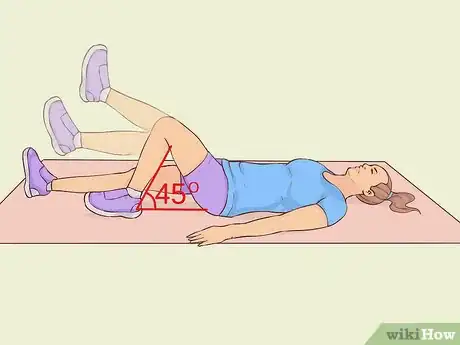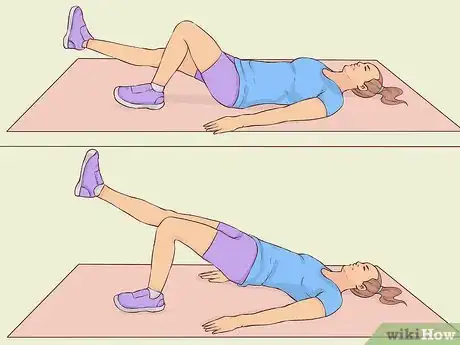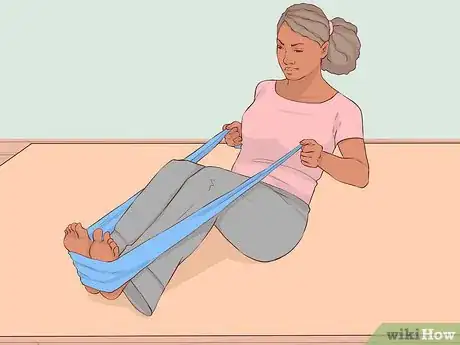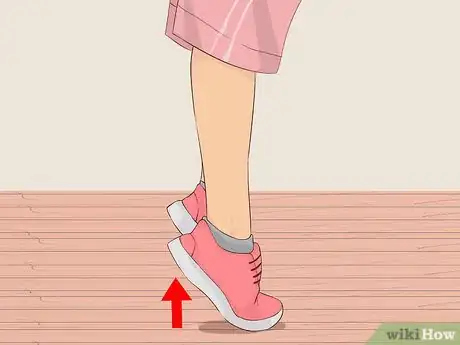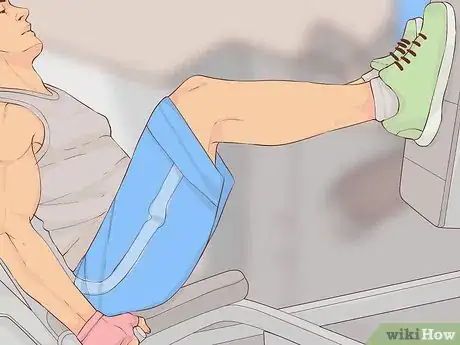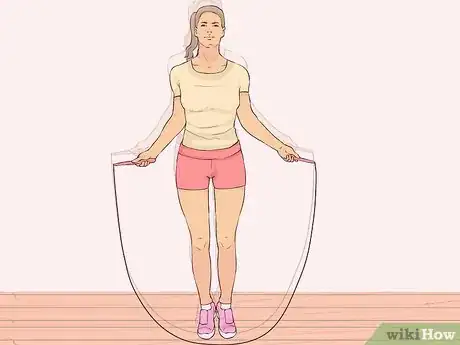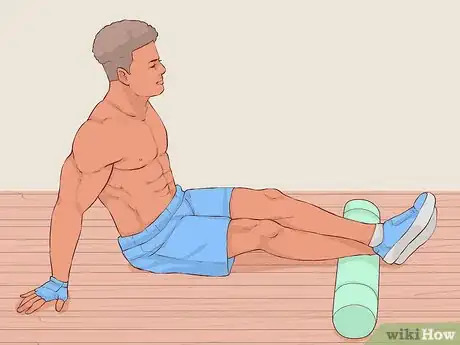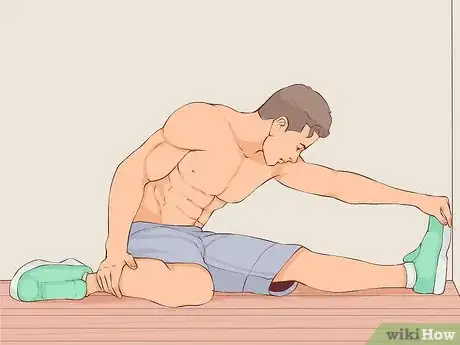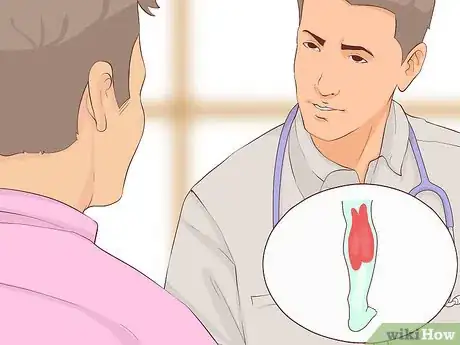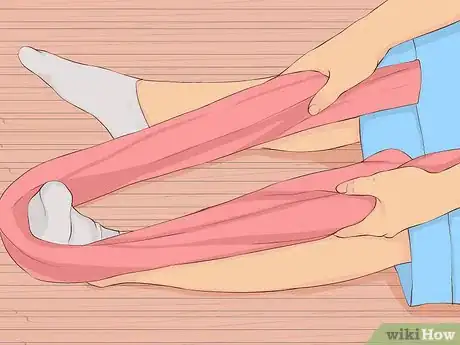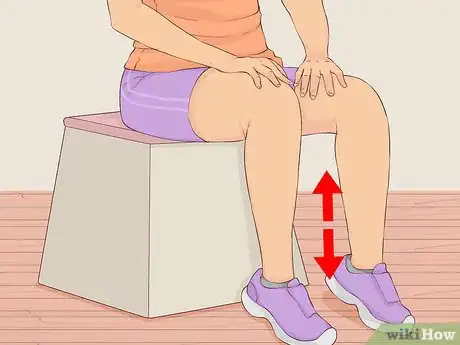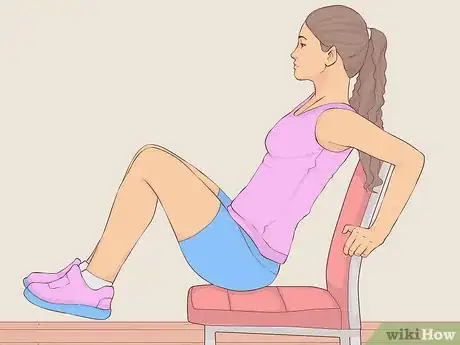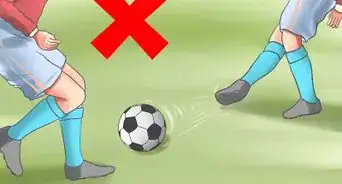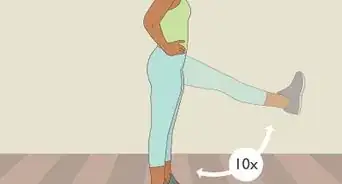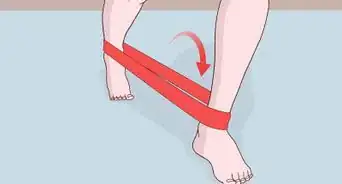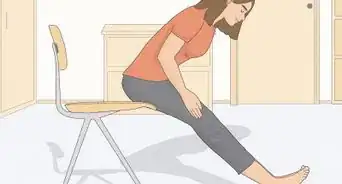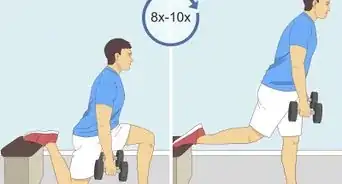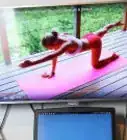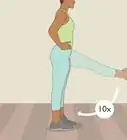This article was co-authored by Francisco Gomez and by wikiHow staff writer, Jennifer Mueller, JD. Francisco Gomez is the Head Coach at the FIT Potato Gym, a training gym established in 2001 in the San Francisco Bay Area. Francisco is a former competitive runner who helps endurance athletes train for major marathons like the Boston Marathon. Francisco specializes in Injury Rehab, Flexibility, Marathon Training, and Senior Fitness. He has a B.S. in Nutrition and Exercise Physiology & Running.
There are 10 references cited in this article, which can be found at the bottom of the page.
This article has been viewed 134,151 times.
The muscles on the back of your lower leg, stretching between your ankle and your knee, are known collectively as your calves. This muscle group serves many different functions, including assisting your ability to stand on your toes and rotate your feet inward or outward. When your calves are weak or underdeveloped, the muscles are more easily overexerted, which can lead to pain and injury. Since you use your calf muscles frequently when walking or running, an injury to your calves can significantly limit your mobility. Prevent painful injuries to the calves by performing exercises and activities to strengthen the calf muscles.[1]
Steps
Building Strength in Your Calves
-
1Do foot boxes. As you build strength in your calves, you shouldn't neglect the surrounding muscles, or the imbalance in strength could lead to injury. Foot boxes can help build and maintain the muscles in your entire lower leg.[2]
- To start this series of four exercises, you should lie on your back on the floor with one knee at a 45-degree angle. Repeat each movement six times and then do it with the other leg.
- Start your box by placing your foot down firmly on the floor. Keeping your foot flat on the floor, slowly rotate your foot inward. You'll feel the muscle in the back of your lower leg contract. Keep your foot turned inward as far as you can go without pain or cramping for six seconds, then rotate it back to center.
- Lift your toes up as high as you can towards your shin while keeping your heel firmly on the floor. Curl your toes and slowly rotate your foot inward. You'll feel this on the front of your lower leg. Hold for six seconds then return your foot to its previous position.
- Again with your heel on the floor, lift your toes up as high towards your shin as you can. This time, curl your toes while rotating your foot outward to work the outside of your lower leg. Hold for six seconds, then return your foot flat to center flat on the floor.
- For the final "side" of the box, rotate your foot outward with your entire foot flat on the floor. Hold this for six seconds, feeling the muscle on the outside of your lower leg contract.
-
2Try single-leg glute bridges. While this exercise, as the name implies, primarily works your glutes, it also increases the strength and stability of your calves, particularly in the leg that remains bent.[3]
- Start this exercise lying on your back on the floor. One leg should be bent so that your foot is firmly on the floor. Your other leg should be extended up and out in a straight line from your hips to your toes.
- Contract your glutes and core to lift your pelvis off the ground. Make sure your shoulders remain flat on the ground. Hold for a second, then slowly release. Do 10 repetitions, then swap legs.
- If you want to add resistance and difficulty to this exercise, you can do it with the foot of your bent leg resting on a stability ball rather than on the floor.
Advertisement -
3Use resistance bands. Calf strengthening using resistance bands is generally safe for anyone to do, regardless of your level of fitness. However, if you've had a calf strain or other lower leg injury, you should first consult your doctor or physical therapist.[4]
- If you don't have resistance bands, you can buy a set at any sporting goods store and at many discount stores for around $20 in U.S. currency.
- Use a loop band or tie a long band into a loop 12" to 15" or 30 to 40 cm in diameter. Then, loop the resistance band around your foot with your toes pointed up toward the ceiling. Holding the band tight, push your foot and ankle down against the band as far as comfortable.
- Hold the position for a second, then return back to your starting position slowly. Do 10 repetitions, then switch to your other foot.
- Donkey kicks are another exercise you can do with resistance bands. Start this exercise on all fours, wrapping one end of the resistance band around the bottom of your foot and the other end around your knee. Slowly extend your leg back and up, then return back to all fours in a slow and controlled manner. Do three sets of 10, then switch to the other leg.[5]
-
4Start with calf raises on the floor. Standing calf raises are a slightly tougher strengthening exercise than using resistance bands because you're using your own body weight as resistance. Make sure you have a chair or countertop you can use for balance as you do this exercise.[6]
- Your feet should be about shoulder-width apart, with your toes facing forward (not turned inward or outward). Slowly rise onto your toes, going as high as you can without pain. Feel your calf muscles contracting.
- Slowly lower yourself back down, taking care to control the movement – don't just drop to your heels.
- Complete this exercise 10 times, then rest for about 30 seconds before doing another set. Try to complete three sets if you can do so without pain.
-
5Work up to calf raises on a step. Doing calf raises from a step is more challenging, and provides more resistance, than calf raises on a flat floor. Because your heels are dropped below the level of the rest of your foot, you're working from a deficit.[7]
- Stand on a step with the edge of the step at the middle of your foot. Your toes and the balls of your feet should be firmly on the step, your heels out over the edge.
- Making sure you have a railing or something to hold onto for balance, lower your heels below the level of the step, as far as you can comfortably go.
- Roll up onto your toes slowly, contracting your calves to raise your heel as high as you can go. Then lower back down in a slow, controlled movement.
- As with regular calf raises, you should do three sets of 10 repetitions, with a brief rest between sets.
-
6Train your calves on a leg press machine. If you have access to a gym, the leg press machine is a good tool to isolate your calves and build strength if you've progressed beyond body-weight exercises. If you don't have access to a gym, holding dumbbells in the hands or doing single leg calf raises greatly increases the resistance.[8]
- Sit up straight on the machine with your body at a 90-degree angle. Move the platform into position and adjust it as needed until the balls of your feet are on the lowest edge of the platform and your heels are free.
- If you turn your toes inward, you can build your outer calf muscles, which can be difficult to strengthen otherwise. Turning your toes outward works the inner calf muscles.
- As you do calf raises on the machine, you can vary the angles of your toes to work the entirety of your calves evenly.
-
7Add plyometrics and vertical activities to build explosive power. If you really want to increase the strength in your calves for vertical jumps and increased speed off the mark, you may want to look into plyometrics to help build fast-twitch muscle.[9]
- The best plyometrics for calf muscles are jumping or hopping exercises. If you're interested in starting a plyometrics routine, talk to a certified trainer. Plyometrics were designed to strengthen and condition professional athletes, and you must have a certain level of conditioning before a full routine is considered safe to perform on a regular basis.
- What you can do as a beginner is add some vertical components to your routine, particularly to your cardiovascular exercise. This comes into play when you run uphill or climb stairs. Cycling also is good for strengthening your calves.
- You also might try sports that require sprinting and changing direction a lot, such as soccer or tennis.
Stretching Your Calves
-
1Warm up before stretching. While stretching may be an important part of your warm-up before you begin any other exercise routine, you should perform a general warm-up before any stretching to help loosen your muscles and prevent injury.[10]
- A general warm up essentially is designed to raise your body temperature between one and three degrees above resting temperature.
- If you're going to be stretching your calves, it's important to warm up your entire lower body. Rotate your joints, then spend at least five minutes doing a cardiovascular activity such as jumping rope or jogging in place.
-
2Increase flexibility with the calf release technique. Technically called the Calf Self Myofascial Release technique, or Calf SMFR, this stretch will improve the flexibility and mobility of your calf muscles and help you release tension in the muscles.[11]
- To begin this technique, lie on your back on the floor with your legs outstretched and your feet in front of you. Put a foam roller under your calves.
- Be careful not to tense up or flex your calves against the roller, and keep your feet relaxed.
- Put one leg on top of the other, lightly crossing your ankles. Raise up onto your hands and engage your core, then slowly move your calf up and down the roller, rotating from side to side to reach the entirety of the muscle.
- If you find a tight or tender area, focus on it, holding the muscle on the roller, breathing deeply.
- Spend between 30 and 60 seconds on one leg, then rest for a minute and switch to the other leg.
- You should do this before any static stretching. You may want to do it after static stretching as well.
-
3Perform static stretches of your calves. After you've completed SMFR, stretch your calves by moving over to a wall and removing your shoes. Lean forward with your elbows and forearms lightly resting against the wall and your back straight.[12]
- Step back so that your body is roughly diagonal to the wall. Pull one leg forward and leave one leg back behind you. Contract all the muscles in your back leg except your calves, pressing your heel into the floor.
- Hold the stretch for 30 seconds, then switch and do the other leg.
Rehabilitating Your Calves after Injury
-
1Work closely with your doctor or physical therapist. Depending on the degree of severity of your injury, you may not have a physical therapist. However, you still should consult a medical professional if you are trying to rebuild your calves following an injury, no matter how minor. Working your muscle too hard following a strain or tear can result in re-injury.[13]
- If you didn't work with a medical professional following your injury, seek out a personal trainer who has experience rebuilding calf muscles after injuries and explain the type of injury you believe you had and how it happened. They can help you find the exercises that would be best for you.
- Start with the easiest exercises and work your way up. Do not do any more strengthening or stretching than you can do without pain.
-
2Start with range-of-motion exercises. Particularly with torn muscles, the most important aspect of your rehabilitation after injury will be regaining full range of motion. As scar tissue forms, you have to ensure it does not form in a way that may increase your chance of re-injury.
- Massage and work with rollers is another way to help orientate the scar tissue and make sure your muscle heals properly.
- One range-of-motion exercise involves sitting on the floor with your legs out in front of you. Keep your knees straight, and bend your toes toward your shins. Hold that position for 5 to 10 seconds, then move your foot slowly back until it's straight up. Repeat 30 times.[14]
- Continue range-of-motion exercises until you feel that you can move in roughly the same ways you could before with little to no pain or discomfort.
-
3Move up to towel stretches and wall stretches. Towel stretches are similar to resistance band stretches, but allow you to control the intensity of the stretch and the level of resistance more easily. Perform this exercise both with your knee extended and again with your knee flexed to work the entire complex of calf muscles.[15]
- Start out by lying on your back with one leg extended out flat. Hold onto the ends of a towel and place your foot in the middle of the towel. Then, extend your leg away from your body, using your grip on the towel ends to pull your toes back.
- Hold the position for at least 20 seconds before switching legs. If you are prone to calf cramps or tightness in your calf muscles, then hold the stretch for 60 seconds or until the tension of the stretch eases.
-
4Do seated calf raises. Seated calf raises are a good strengthening exercise to do early on in your physical therapy or rehabilitation because they can be done with little to no resistance since you are sitting in a chair.[16]
- Find a chair you can sit in with your feet flat on the floor. From a forward seated position, raise your heels off the ground as high as you can without pain, then slowly lower them to the floor with controlled movement. Do 10 repetitions to make one set.
- Start with two sets a day and add more sets as your strength improves and you can do them without pain.
- You can increase the resistance on this exercise by resting a weight on your knees, such as a heavy book.
-
5Work back into strength training gradually. Make sure you've gained full range of motion before you start trying to rebuild the strength in your calves. Keep in mind that if you had a tear, it will take at least six weeks for scar tissue to form.
- After the six-week period, start with strength-building exercises such as seated exercises that don't use your body weight. Work your way up to partial, then full body weight.
- Once you can do full-body-weight exercises without pain or discomfort, you're ready to add resistance and start really rebuilding your strength.
- When you get back into strength-building, you also may want to add some speed or agility training, depending on the activities you normally pursue and how you were injured.
How Do I Build Bigger Calves?
Expert Q&A
-
QuestionHow can I do calf exercises while I am wearing a protective boot?
 Michele DolanMichele Dolan is a BCRPA certified Personal Trainer in British Columbia. She has been a personal trainer and fitness instructor since 2002.
Michele DolanMichele Dolan is a BCRPA certified Personal Trainer in British Columbia. She has been a personal trainer and fitness instructor since 2002.
Certified Fitness Trainer You can work your calf muscles while wearing protective boots by standing on the edge of a step or stair. Just the front half of the foot is supported, the heel hangs over the edge of the step. Hold this position as long as possible (up to 60 seconds). If that is easy, try the same exercise, standing on just one leg, only the front half of the foot supported.
You can work your calf muscles while wearing protective boots by standing on the edge of a step or stair. Just the front half of the foot is supported, the heel hangs over the edge of the step. Hold this position as long as possible (up to 60 seconds). If that is easy, try the same exercise, standing on just one leg, only the front half of the foot supported. -
QuestionWhat exercises work the calves?
 Michele DolanMichele Dolan is a BCRPA certified Personal Trainer in British Columbia. She has been a personal trainer and fitness instructor since 2002.
Michele DolanMichele Dolan is a BCRPA certified Personal Trainer in British Columbia. She has been a personal trainer and fitness instructor since 2002.
Certified Fitness Trainer As a few examples, calf raises, running and skipping are all great exercises for the calves.
As a few examples, calf raises, running and skipping are all great exercises for the calves. -
QuestionWhat exercises make your legs stronger?
 Michele DolanMichele Dolan is a BCRPA certified Personal Trainer in British Columbia. She has been a personal trainer and fitness instructor since 2002.
Michele DolanMichele Dolan is a BCRPA certified Personal Trainer in British Columbia. She has been a personal trainer and fitness instructor since 2002.
Certified Fitness Trainer Squats and lunges are the foundational leg strengthening exercises. Jumps are also fantastic for working the fast-twitch muscle fibers.
Squats and lunges are the foundational leg strengthening exercises. Jumps are also fantastic for working the fast-twitch muscle fibers.
References
- ↑ https://breakingmuscle.com/learn/building-better-calf-muscles-how-the-calf-works-and-how-to-work-it
- ↑ http://www.active.com/fitness/articles/4-exercises-to-strengthen-your-lower-legs
- ↑ https://runnersconnect.net/running-training-articles/how-to-strengthen-your-calves-and-achilles-to-prevent-injury/
- ↑ http://www.physioadvisor.com.au/exercises/strengthening-muscles/calf/
- ↑ https://runnersconnect.net/running-training-articles/how-to-strengthen-your-calves-and-achilles-to-prevent-injury/
- ↑ http://www.physioadvisor.com.au/exercises/strengthening-muscles/calf/
- ↑ http://www.physioadvisor.com.au/exercises/strengthening-muscles/calf/
- ↑ http://www.muscleandfitness.com/workouts/legs-exercises/gym-fix-build-bigger-calves-exercise
- ↑ http://www.askthetrainer.com/best-calf-exercises/
- ↑ http://web.mit.edu/tkd/stretch/stretching_5.html
- ↑ http://www.lightfield.com/etc/Self_Myofascial_ReleaseMM.pdf
- ↑ http://www.askthetrainer.com/best-calf-exercises/
- ↑ http://www.sportsinjuryclinic.net/sport-injuries/ankle-achilles-shin-pain/calf-strain/calf-strain-strengthening-exercises
- ↑ http://www.physioroom.com/experts/asktheexperts/answers/qa_mb_20040728.php
- ↑ http://www.physioroom.com/experts/asktheexperts/answers/qa_mb_20040728.php
- ↑ http://www.sportsinjuryclinic.net/sport-injuries/ankle-achilles-shin-pain/calf-strain/calf-strain-strengthening-exercises
- ↑ http://www.physioadvisor.com.au/exercises/strengthening-muscles/calf/
